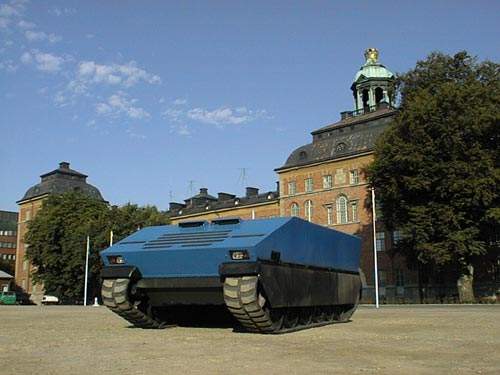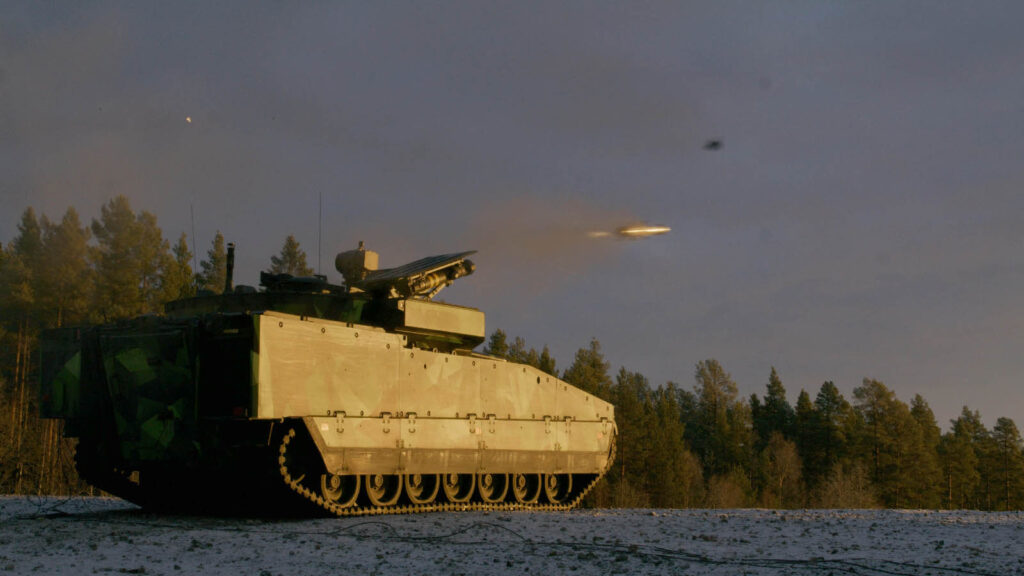- Reaction score
- 7,105
- Points
- 1,140
I think we could get Hugo Boss onboard...Does it come with snazzy uniforms?

I think we could get Hugo Boss onboard...Does it come with snazzy uniforms?
Reference cited M2/M3 Bradley at war : Green, Michael, 1952- : Free Download, Borrow, and Streaming : Internet ArchiveThe other alternate vehicle was the West German Marder, which mounted a 20 mm autocannon, relatively strong steel armor, and full CBR protection. The U.S. Army rejected it due to it not being amphibious, too large and heavy for air transport, and too expensive.[10]
Your source posted only covers 4 pages. Do you have an example of how the m113 was caught predating FM 7-7? I find it more than suspect that they expect m113s to fight as Bradley’s, given they deployed m113 equipped units into desert storm.The BMP was introduced into service in 1966, the Marder in 1971.
The Russians and the Germans were leading the way on the mounted assault and had tools designed for the purpose with 15 to 20 years of experience of operations by 1985.
The US in the middle of the AirLand battle reorg. They needed their own assault vehicle.
Enter the Bradley, in gestation since 1963. The committee's camel entered service in 1981. The M113 equipped units were expected to emulate the Marder tactics until they got their Bradleys. The Bradleys started to come in service in 1981.
Peculiarly wiki has this to say about why the US Army rejected the Marder concept.
Reference cited M2/M3 Bradley at war : Green, Michael, 1952- : Free Download, Borrow, and Streaming : Internet Archive
Mind you no one every expected to see LVTP-7 trundling through the desert either.Your source posted only covers 4 pages. Do you have an example of how the m113 was caught predating FM 7-7? I find it more than suspect that they expect m113s to fight as Bradley’s, given they deployed m113 equipped units into desert storm.
No but my point was that they m113s since the 1960s, it seems absurd to have them start to train to be Bradley’s when they were a decade away from receiving them.Mind you no one every expected to see LVTP-7 trundling through the desert either.
Maybe the US Army had DeLoreans... But grounded them because Congress wouldn't fund enough flux capacitors.No but my point was that they m113s since the 1960s, it seems absurd to have them start to train to be Bradley’s when they were a decade away from receiving them.
That’s actually not true. If you read the US Army field manual for Mechanized Infantry (1985) it makes it clear that a) they were only to attack dismounted when terrain forced them or enemy AT weapons couldn’t be suppressed and b) the carriers were expected to support by fire in all attacks. 5-20 covers mounted assaults with and without tanks infect.
So by doctrine, not just by use, it was absolutely intended to be driven at the enemy.
Your source posted only covers 4 pages. Do you have an example of how the m113 was caught predating FM 7-7? I find it more than suspect that they expect m113s to fight as Bradley’s, given they deployed m113 equipped units into desert storm.
I think you’ll find reading 7-7 that “the Carriers form the base of fire” is the phrase used over and over again. The intent was never to dismount their .50s and drag them into a support by fire position. If you go up to 5-15-8 is states very clearly the platoon attacks dismounted in two specific cases. The implication being unless required attack mounted, and dismount for the assault. To me at least.Do I misunderstand you?
FM7-7 of 1977 appears to call for rapid mounted movement when out of contact and using the terrain for cover and concealment. It also says to stay mounted until terrain or enemy action demands dismounted action. If bounced by the enemy while mounted then put all weapons on full auto and return fire to suppress the enemy. Aside from the full auto bit that sounds a lot like the army that trained me. Nobody was under any illusions that the vehicle offered much in the way of cover nor was it a platform for effective aimed fire when mounted.
As the manual says the M113 was a mobile base for the infantry. Most of the movement in proximity and contact appears to me to emphasize dismounted drills. Even the carrier's 50 is discussed in terms of "when" the 50 is mounted, recognizing that some or all of the 50s could be dismounted to support a defensive fire plan or provide support from an unexpected angle.
By 1985, when the Bradley was in limited service and airland was calling for shock and awe tactics I read you interpreting the manual as requiring the platoon to attack mounted unless forced to dismount.
Is there perhaps a difference of opinion over the wording? My inclination, all things considered, would be to stay mounted when out of contact and, in the right terrain, when advancing to contact. If bounced on the line of march then an effective ambush drill would be to return fire and manouevre the vehicle(s) out of the engagement zone if possible. If doing a mounted advance to contact then the issue becomes how effective is the effective fire. Some attacks could be carried out with an immediate assault while mounted but many/most(?) might be better prosecuted dismounted with a degree of deliberation.
If we had had Marders or Bradleys perhaps we might have been more inclined to stay mounted longer and push forwards farther - partly because enemy fire would have been less effective against the more heavily armoured vehicles.
But I have always been a cautious, plodding individual. Perhaps I am seeing what I want to see.
This made me recall that in my entire career I only FOO'd once for an American battalion. It was a winter REFORGER where we adopted the crew of an M60 that had slid down a hill, dropped both tracks and was abandoned by its company, met Alexander Haig as he visited the battalion TOC (talk about Spartan) and where we set up our M113 next to a gasthof, remoted our radios inside and spent the next 48 hours consuming beer and goulash soup. It was not a great learning experience about US tactics.I think you’ll find reading 7-7 that “the Carriers form the base of fire” is the phrase used over and over again. The intent was never to dismount their .50s and drag them into a support by fire position. If you go up to 5-15-8 is states very clearly the platoon attacks dismounted in two specific cases. The implication being unless required attack mounted, and dismount for the assault. To me at least.


Sweden’s armed forces are hoping to adopt a next-generation, potentially hybrid version of the CV-90 infantry fighting vehicle (IFV) in “record time” given the ongoing conflict in Ukraine, according to the commander of the Swedish Army.
Importantly, the next-gen CV90 would also feature a hybrid electric engine which MG Engelbrektson described as an important requirement for the Swedish Army to support more environmentally friendly peacetime training and combat operations.
Tracked SEP
The tracked vehicles are fitted with rubber bandtracks rather than conventional steel link tracks. The bandtracks are lighter, quieter and have a longer operational life. The noise developed by the running gear is reduced by about 6dB. Bandtracks also have a lower rolling resistance. Band track technology has been used previously by Land Systems Hagglunds on the Bv206 articulated carriers which use short track length bandtracks.
In the SEP tracked vehicle the suspension is mounted on the underframe and not on the side frames, so the suspension is separated from the hull. A result of using a decoupled suspension and bandtracks is that the internal noise level is as low as 85dB which is sufficiently low to meet civilian vehicle noise requirements.
The decoupled suspension also provides a spaced outer layer which gives improved protection against mines. The SEP vehicle can withstand a 7kg TNT explosion under a track.
The company Ingenieurebureau Deisenroth (IBD), based in Germany, has developed a SEP protection kit that provides protection against advanced mines with explosively formed penetrators.
Ok guys, I'm old. The convention for abbreviations usta was - First use spell it out with abbn in brackets following. Can we try that here? Especially for us acronymic challenged folks.I doubt BAE is dusting off old plans. More likely multiple revisions have been done since.
They have been doing a lot of IRD on the CV90 for years, one reason I suspect they eventually opted out of OMFV here is it went counter to directions they had heavily leaned into.
IRD - Internal Research and DevelopmentOk guys, I'm old. The convention for abbreviations usta was - First use spell it out with abbn in brackets following. Can we try that here? Especially for us acronymic challenged folks.
Never assume your acronyms are universal. The Feds here have SAR = Salmon Aquaculture Review and OPP = Ocean Protection Program, which must be fun for the Ontario region when they need to engage the OPP as part of their OPP plans.IRD - Internal Research and Development
OMFV - Optionally Manned Fighting Vehicle, the M2A4 Bradley replacement program (there is a thread on it and it’s two down selections elsewhere here).
I thought those two terms where fairly common use, so I didn’t think I needed to give them an explanation
That is a massive turret/gun. Is the US Army sure that is the way that they want to go on this?
